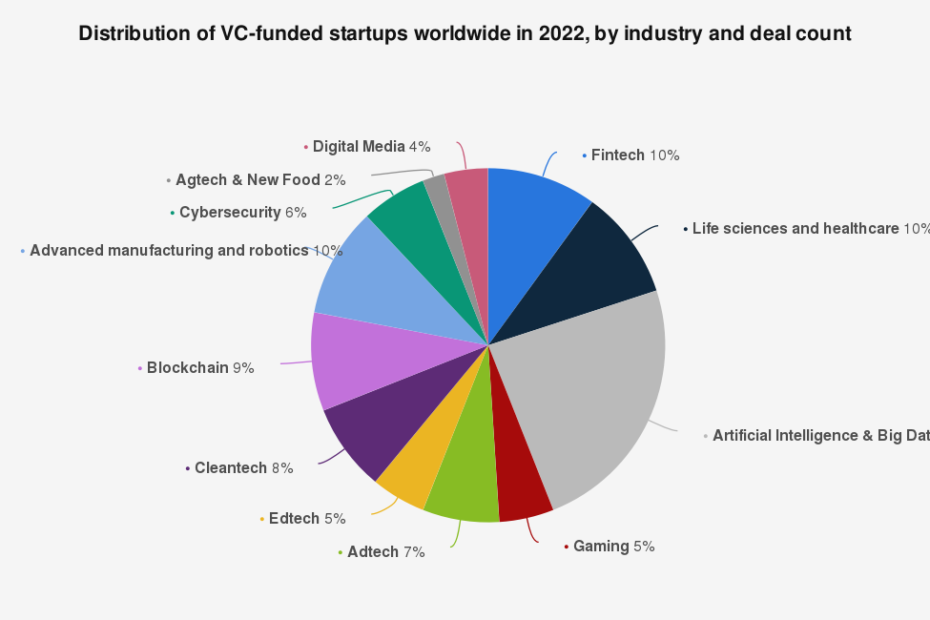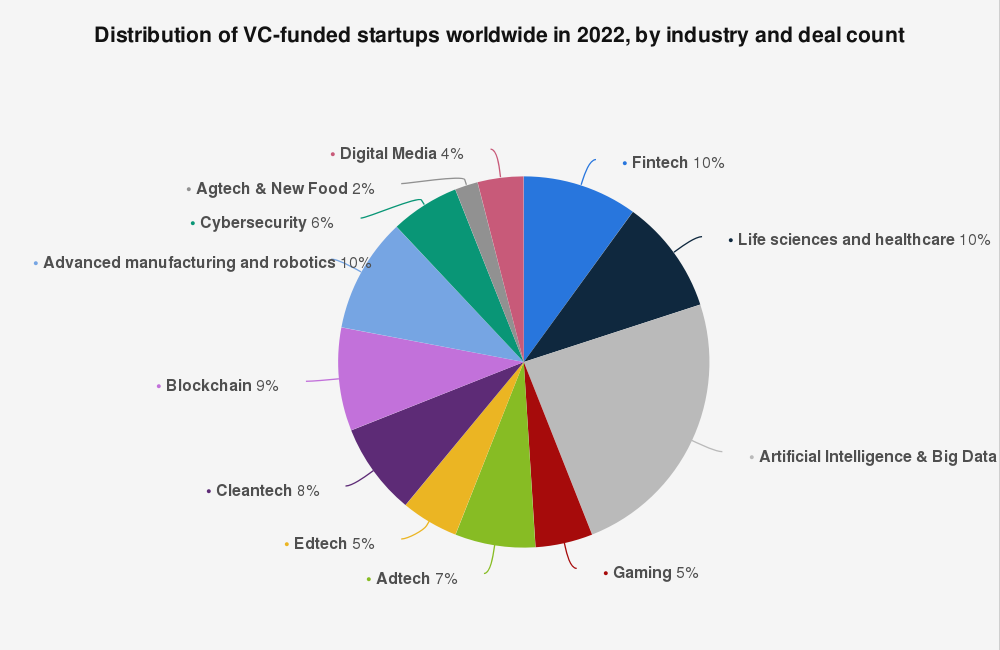Fueled by technology and digital transformation, competition is heating up across practically every industry. As Figure 1 shows, startups are exploding worldwide – disrupting established players. In 2022 alone, over 1 million new startups entered markets globally.
Figure 1. Global startup ecosystem by industry (Source: Statista)
This exponential rise in competition means businesses must be on top of their game to survive and stay profitable.Implementing effective competitive intelligence (CI) strategies is no longer optional – it‘s imperative for success.
This in-depth guide will explore competitive intelligence, its manifold benefits, best practices for implementation, tools, and the future outlook. Let‘s get started.
What is Competitive Intelligence?
Competitive intelligence refers to the systematic collection, analysis, and application of information regarding competitors‘ products, offerings, pricing, customers, business strategies and more. It aims to equip businesses with strategic insights and actionable intelligence to outperform rivals.
The key goals of competitive intelligence include:
-
Identifying threats and opportunities: Spot emerging opportunities, like new technologies, along with potential threats from new innovations or competitors. This allows companies to capitalize on opportunities and mitigate risks proactively.
-
Informing business strategy: Analyze competitors‘ business models, core capabilities, weaknesses, plans, etc. to make smart strategic decisions and refine business plans.
-
Supporting tactical decisions: Guide pricing, product development, marketing strategies, and more based on intelligence on competitors‘ tactics, customer feedback, promotions, etc.
-
Predicting future moves: Anticipate competitors‘ future strategies and product/service launches based on patents, hirings, investments and more. This ensures readiness to respond swiftly.
Some common CI methods include SWOT analysis of competitors, win/loss analysis, monitoring online conversations, and analyzing competitors‘ annual reports. Advanced analytics augments human analysis to derive strategic insights from voluminous data.
For instance, a retailer selling consumer electronics may track its rivals‘ product catalogs and pricing closely. When competitors launch aggressive holiday discounts, it can tweak its own discounts to stay competitive. This level of agility is only possible with systematic CI.
Now let‘s explore the manifold benefits of investing in competitive intelligence.
5 Key Benefits of Competitive Intelligence
Implementing competitive intelligence offers significant advantages, including:
1. Identify Emerging Opportunities and Threats Early
Continuous competitive monitoring allows businesses to spot emerging opportunities, like new technologies, changing regulations, or buyer needs, faster than competitors.
For example, Lululemon realized the growing consumer shift to casual and work-from-home clothing during COVID. It swiftly pivoted to casual wear and achieved tremendous growth.
CI also surfaces potential threats, like new industry entrants, M&A activities, or disruptive innovations, giving companies more time to prepare contingency plans.
For instance, Blockbuster could have mitigated the threat from streaming services by monitoring Netflix‘s soaring popularity and adapting their model early on.
| Companies Investing in CI | Companies Not Investing in CI |
|---|---|
| 45% higher sales growth | 12% lower sales growth |
| 38% higher profit growth | 8% lower profit growth |
| 23% higher market share | Loss of market share |
Stats Source: Survey of Retail Companies by Intelligence Company XYZ
As the above data indicates, companies investing in competitive intelligence far outperform others.
2. Make Pricing and Promotions More Competitive
Pricing optimization is a top use of competitive intelligence. By benchmarking competitors‘ pricing models for specific products, companies can set optimal prices.
Factors like production costs, customer willingness to pay, competitor prices, demand forecasts, and price elasticity are analyzed to guide pricing.
CI also provides intelligence on promotional strategies. Competitors‘ product bundling, discount levels, seasonal offers, and more are monitored to devise competitive promotions.
For example, during the holiday season, an online retailer may scrape competitors‘ sites to compare discounts across electronics like TVs. It can then adjust its own holiday pricing on those items to stay appealing to customers.
3. Exceed Customer Expectations
Competitive intelligence provides unparalleled insights into customers‘ pain points, unmet needs, and evolving preferences.
For instance, car companies conduct buyer surveys to benchmark their models against competitors‘ across metrics like safety, performance, features, and test drive experience. This reveals areas to improve.
Focus groups and social media monitoring also uncover opportunities to enhance products and exceed customer expectations compared to alternatives. Companies can then integrate these findings into R&D and product roadmaps.
4. Make Marketing Strategies More Impactful
Sharpening marketing strategies is another benefit of competitive intelligence. Competitor analysis reveals optimal media mix, messaging themes, ad creatives, and campaign strategies.
For example, by analyzing competitors‘ social media presence and activity, companies can derive best practices for content types, posting cadence, hashtag usage, influencer marketing and more.
Monitoring competitors‘ SEO strategies reveals opportunities to improve website optimization, earn quality backlinks faster, and climb search rankings.
5. Get Advance Warning of Disruption
Besides opportunities and threats from known competitors, CI also keeps companies alert to unexpected industry disruptions.
For instance, emerging technologies, patent filings by competitors, regulatory changes, and new startup funding can forewarn companies of potential disruption. This early insight allows adequate preparation.
In the 2000s, Nokia could have anticipated the smartphones disruption better by tracking relevant patents by Apple and Google along with changing customer needs and behaviors.
In summary, competitive intelligence is indispensable for gaining strategic advantages in today‘s cutthroat business environment. But what‘s the best way to implement competitive intelligence?
5 Best Practices for Effective Competitive Intelligence
Here are five tips to help implement competitive intelligence successfully:
1. Monitor Competitors Continuously
Regular monitoring of competitors‘ digital assets reveals the latest strategies and tactics. Set up automated alerts when key changes occur.
Websites/apps: Check for updates to product catalog, pricing, packaging, messaging, etc. Web scraping tools help automate monitoring at scale.
Social media: Analyze engagement levels, new campaigns, and conversations to optimize your social presence.
Mobile apps: Download competitors‘ apps to review features, UI/UX, promotions, etc. Look for areas to enhance your own app.
Job listings: New openings indicate upcoming initiatives and technologies competitors are investing in.
Press releases: Reveal new products, services, technologies, and partnerships.
2. Listen on Social Media
Social listening identifies new launches, brand perceptions, and customer feedback ahead of competitors.
Use social media monitoring tools to analyze competitors‘ posting patterns, engagements, influencer marketing, and conversations. Spot opportunities to refine your social media strategy.
Subscribe to competitors‘ social accounts and join relevant social groups to see posts in real-time. Monitor reviews and comments on social platforms like Instagram and Facebook.
3. Conduct Primary Research
While secondary sources provide ample data, original primary research reveals nuanced qualitative insights.
Surveys and interviews with customers uncover real experiences with competitors‘ offerings and areas for improvement.
Focus groups dispel assumptions and provide unfiltered consumer perspectives. Panels allow tapping into different demographics.
Avoid leading questions to prevent bias. Welcome brutal feedback to address weaknesses.
4. Network at Industry Events
Industry networking offers insider competitive insights.
At conferences, identify sessions attended by competitors. Strike conversations to gather information. Share limited info to build reciprocity.
Visit competitors‘ booths at trade shows to check out upcoming products and technologies.
5. Build an In-House CI Team
For large enterprises, build a dedicated in-house CI team for consistent competitive insights. Look for candidates with backgrounds in data analytics, market research, and business strategy.
Clearly define responsibilities:
- Data collection and analysis
- Monitoring initiatives and reporting
- Strategic recommendations
- Data visualization and presentation
Foster close coordination between the CI team and company leadership to swiftly convert intelligence into action.
Pitfalls to Avoid
While implementing CI, beware of:
-
Information overload: Focus on quality insights tailored to strategic goals rather than amassing data.
-
Lack of coordination: Align CI team, executives, and decision-makers.
-
Data leaks: Institute rigorous cybersecurity protocols. Anonymize customer data.
-
Bad data: Carefully vet sources and data credibility.
-
Biased analysis: Remain objective; don‘t skew insights to align with company views or assumptions.
Competitive Intelligence Software and Tools
While parts of competitive intelligence rely on manual monitoring and primary research, technology can turbo-charge productivity:
Web Scraping Tools
Programs that extract data from websites. Helpful for monitoring competitors‘ sites, pricing, promotions, etc.
Pros: Automated monitoring, handles large sites, custom extraction
Cons: Setup complexity, limited social media support, ethical concerns
Examples: Import.io, ScraperAPI, Octoparse
Social Media Monitoring Tools
Collect social media data to reveal competitors‘ strategies.
Pros: Real-time monitoring, easy analysis, visualizations
Cons: Limited historical data, privacy concerns
Examples: Mention, Keyhole, Sprout Social
Search Intelligence Tools
Provide intelligence on competitors‘ SEO and PPC strategies.
Pros: SEO metrics and audits, competitor keyword tracking
Cons: Steep learning curve, extensive configuration
Examples: SEMRush, Ahrefs, Moz, SpyFu
Business Intelligence Software
Integrate and analyze competitor and market data to support decisions.
Pros: Sophisticated analysis and models, visualizations
Cons: High costs, complex implementation
Examples: Microsoft Power BI, Tableau, Qlik
AI-powered Market/Competitive Intelligence Platforms
End-to-end automated competitor monitoring and intelligence.
Pros: Automation, ease of use, actionable insights
Cons: High costs for extensive capabilities
Examples: BrightData, Cintell
Real-World Competitive Intelligence Success Stories
Here are some examples of competitive intelligence elevating business performance:
-
Nike: When launching their sportswear line, Nike analyzed competitive brands regarding pricing, promotions, endorsements, segmentation, etc. This fueled Nike‘s meteoric rise.
-
Starbucks: Starbucks closely studied upscale coffee houses to recreate the experience affordably. Monitoring rivals‘ new beverages and food items informs menu innovation.
-
Walmart: Walmart‘s everyday low pricing strategy was informed by meticulous monitoring of rivals‘ pricing models and promotions using advanced analytics. This helped crush competition.
-
Coca-Cola: When launching Diet Coke, Coca-Cola reviewed tactics and formulations of competing diet sodas. CI fuels Coke‘s marketing and product innovation.
These examples highlight how competitive intelligence unlocks enduring competitive advantages. Adopting CI best practices can help companies in any industry achieve similar success.
The Future of Competitive Intelligence
As technology progresses, here are some predictions for competitive intelligence:
-
Artificial intelligence and machine learning will transform analysis of vast amounts of data to derive deeper strategic insights faster.
-
Social listening and real-time monitoring of competitors will become more critical as business speeds accelerate.
-
Data visualization will make extracting intelligence more intuitive and efficient for business users.
-
As competition intensifies, more companies will adopt competitive intelligence as a core capability and hire dedicated CI staff.
-
Cloud-based intelligence platforms will enable easy access to CI capabilities for businesses of all sizes.
-
Competitive intelligence professionals will be in huge demand, especially in technology, retail, finance, and pharmaceuticals.
Conclusion
As startups disrupt every industry, comprehensive and continuous competitive intelligence has become indispensable for survival and growth. Implementing a robust CI strategy provides strategic foresight so companies can capitalize on emerging opportunities proactively and sidestep potential pitfalls.
Competitive intelligence helps you get inside competitors‘ minds to anticipate moves rather than merely react. Integrating CI best practices, from social listening to primary research to AI-powered monitoring, can elevate business performance, foster innovation, and turbocharge growth.
The time to ramp up your competitive intelligence efforts is now – before competitors leave you behind. Competitive intelligence will separate the market leaders from outdated players. Invest wisely for enduring competitive advantage.

